Reflections on The 25th International IATEFL Slovenia Conference by Ezgi Öner and Nazan Özçınar Sırel
Reflection on
“Smooth Sailing through the Sea of Words” by HUGH DELLAR
Reflection By:
Ezgi Öner (ezgi.oner@ozyegin.edu.tr)
ÖZYEGIN University, ISTANBUL
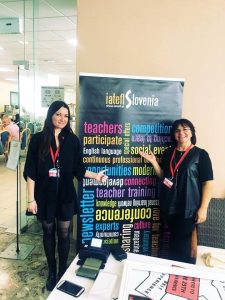
I had a chance to attend 25th International IATEFL Slovenia Conference entitled ‘IMAGINE’ (8th-11th March, 2018) with Nazan Ozcınar Sirel. Attended by many ELT professionals from different countries, the conference involved talks, workshops, plenary sessions by David and Hillary Crystal, Penny Ur, Hugh Dellar, Peter Dyer and Jen MacArthur as well as a vibrant social programme. The programme offered participants a unique experience to meet leading theorists, writers and exchange ideas with professionals not only from ELT sector but also from the field of literature and linguistics with some specific sessions entitled ‘Playing with Shakespeare: facts and fictions’. It was a great pleasure to be a part of it both as a speaker and participant.
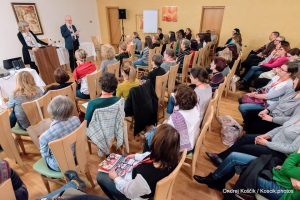
‘Smooth Sailing through the Sea of Words’ was a session ‘intending to attempt a TEFL exorcism’ by Hugh Dellar and he insistently underlines that he tries to remove the curse of creativity that is affecting our profession. He strongly supports the idea that we need to concentrate less on reinventing the wheel and more on caring about doing regular activities as well as we possibly can as John Updike, the novelist, once said that: “Creativity is merely a plus name for regular activity . . . any activity becomes creative when the doer cares about doing it right, or better”.
Times do change and so do the concepts, methods or activities of what to expect in the future. However, I personally believe that indispensably we can’t help but make a comeback with retro at certain intervals even in ELT. It was a really different experience to attend some creative workshops during the conference while we were having such sessions defining creativity as a curse. After all the sessions we, as instructors, have attended on creativity, Hugh Dellar suggests eleven ways we can ward off the curse of creativity below:
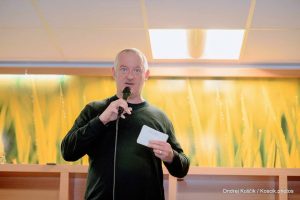
1. Embrace the fact that much of what we do in our day-to-day work is by its very nature repetitive! We check answers to exercises, we explain tasks, we go through listenings, we round up after students have done some speaking . . . and we do these things all the time! Rather than constantly try to find new ways to reinvent the wheel, I think it’s better to develop fixed, generic ways of doing these things – students appreciate the security and it leaves us more time to focus on the harder, more subtle aspects of good teaching.
2. One such aspect involves working the language as you go through exercises. Ask questions about any new words / bits of lexis that students meet in exercises they do in the course book. Try to generate other bits of language around the new word. For example, imagine students have to do this exercise (taken from Innovations Pre-intermediate):
Complete the conversations with the pairs of words:
come + go drive + visit
come + going help + work
and the first two sentences in the exercise are:
A: Sorry, but I can’t ………….. tennis with you this afternoon
B: Oh, OK. Why not?
A: I have to …………… my younger sister from school at three.
A: Sorry, but I can’t ………….. to the meeting tomorrow.
B: Oh. OK. Why not?
A: I have to ………………………… to the dentist’s. I’ve got really bad toothache.
As you’re eliciting the answers from the whole class and writing them on the board, you could also check the following bits of language:
collect my younger sister – explain it means ‘go to the school and take her home’. Give / ask for other places you might collect someone from – Can you collect me from the airport / from the station, I have to collect the kids from a party etc. You could also give the students pick up as a common synonym.
toothache – you could act it out and give / ask for other ‘aches’. You could also ask what happens at the dentist’s if you have really bad toothache – you have a filling / have a tooth out.
Asking questions about the language students meet is not a ‘recipe’ or an ‘activity’. It’s something that becomes part of the way you do things all the time. It’s also something that involves the whole class, can generate humour and ensures everyone in the class goes away having teamed something new. Of course, it’s easier to ask questions like this about some bits of language than others. Everyday language lends itself to exploitation of this nature far more readily than ‘creative’ lexis such as ‘peeling shutters’ or ‘the green darkness’! This is one of the reasons why we’ve tried to make sure Innovations is as full of naturel, social English as possible.
3. Avoid over-creative tasks. Before you do any speaking activity, it’s worth thinking about if you’re asking students to talk about things they’ll have some experience of talking about in their own L1. If not, then the activity isn’t a very good test of how much language students can use! It’s always better to ask students personal questions like these:
Do they know anybody who does X?
Has anything similar to Y ever happened to them?
What do they think about Z and why?
Was there anything in the text they disagreed with or were surprised about?
4. Don’t feel bad about repeating activities if they’re about things the students might actually talk about in their own L1 – or outside of class. If students have had certain kinds of conversations before, that’s good! It means they should be better at them this time around!! In the real world, we all repeat conversations / stories / anecdotes / conference talks (!) all the time and usually the practice gets us nearer perfection! The way to stop boredom setting in is to pick up on new things during the round-up.
5. Round up speaking slots by giving students new, better ways of saying things you heard them trying to say. Encourage students to say what they want to say as best they can (including using their mother tongue if needs be) and then say what they wanted to say in ‘correct’ English. At the end of a speaking activity, you can orally summarize for other students what you heard said. Sometimes, tell the class what certain students tried to say and give them better ways of saying it on the board. For example:
”Samir said I no want live London. Is people. People, people, people! I know what he means, but we say. / don’t want to
live in London. It’s loo crowded (write these two sentences on the board) Crowded means people, people, people
..Samir. crowded in Arabic?”
In this way, the student sees they have communicated what they wanted to say and the ‘correction’ is done in a positive way. Another way of doing this kind of round-up work is to be writing gapped sentences up on the board whilst students are chatting and to then try to elicit (and failing that, simply to give) students the missing words. For example:
Write the following on the board.
I couldn’t live in London. It’s too c………… .
and then say: I heard Samir say he doesn’t like big cities. He thinks there’s too many people in them. They’re too …? Yes, too crowded.
6. There are plenty of other ways to go over things you’ve looked at before in class. Here are a couple of ideas:
(a) Ask students to look back through their notes from the last few lessons. They should write down 2-5 words or expressions that they can’t remember the meaning of. Students then get up and walk round the room to see if anyone else can explain the words to them. Monitor to check students are giving correct definitions and help out where they aren’t. At the end of the task, you can explain
any words that the students had all forgotten and go over some of the other common problems again, eliciting collocations if possible.
(b) Fold an A4 piece of paper in half. On the top half, write Student A and 8-10 words / expressions from the last few lessons. On the bottom half, write Student B and 8-10 more words / expressions. Make half as many copies as you have students in your class. Cut the copies in half. Put the class into pairs – As and Bs. Give the As and Bs their different set of words. They shouldn’t show each other the words and it’s best if they sit facing each other. To begin, Student A explains one of the words in their list – they can talk, act or draw. Student B guesses. Student B then explains one word and A guesses. They continue until they have explained and guessed all the words.
While they work, go round and help out when students are having problems. At the end, you can re-teach some of the vocabulary and elicit extra collocations or connected expressions. Obviously, it’s best if the language being revised is things students might actually want to say themselves or might hear said.
Rote learning has often been seen as anti-creative and anti-communicative. However, the basis of most creative activity, whether it be music, art or acting is frequently simple drills, memorization and repetition. It’s the confidence of rote learning that actually allows a musician or actor to express feeling. Furthermore, for many people – probably most – learning lists offer a clear target and proof of success and is therefore highly satisfying. The problem is therefore less in the activity itself and more to do with the nature of the language we actually ask students to learn. For learning by heart (perhaps a more positive label) to be successful, it has to involve the actual language students need to perform. Students often find learning lists of words frustrating – or unhelpful – because they are single words, useless words given their immediate needs or just bad examples.
Learning lists of single words is unlikely to lead to great success because many basic words are relatively empty in meaning on their own. Take, have, get, go, put etc, only really work in action with other words and collocations vary from language to language. On the other hand, learning lists of less common words frustrates for the very reason that they are uncommon both productively and receptively and particularly uncommon for the immediate needs of most students. Rote learning is most effective and focused if we encourage learners to learn short everyday natural, social expressions and groups of words that often go together.
Rote learning could be used to ‘pre-teach’ language by simply giving students lists of language from a course book unit in advance for them to translate and learn. Students can try and learn the expressions at home before starting on the unit. The exercises you do in class become a check of learning and more time can be devoted to spoken practice and using the language. Of course, rote learning can also be done after class activities and after class as well.
One way you can encourage students to remember what they’ve studied in class is to try this activity at home: Look at a sentence from your course book or notebook. Say the sentence. Cover the sentence. Write the sentence down on a blank piece of paper. Look back and check you have written the sentence correctly.
For most students up to Upper-Intermediate level, translation is a natural part of learning a foreign language. Learners will often record words they learn in class by writing the English AND a translation. They will want to say things in English, but be completely unable to find the words, so they will use a bilingual dictionary, translating from their language to English. As teachers, we should not discourage translation, but rather encourage the RIGHT kind of translation and use L1 to make learning easier.
When students translate or you translate for them, many nouns often have a single direct translation. All the same, it is still a good idea to encourage translation of the verbs and / or adjectives that typically go with the nouns as well. This is important because collocations often don’t translate directly. For instance, in one language you might stay at home and see TV rather than watch T\/.
Multi-Iingual classes and translation.
Even if your students don’t share a common language or you don’t speak their language, translation exercises can still be effective in the class. You can get students to translate expressions onto a separate clean piece of paper, writing only in their language. In pairs, student A can then point to one of the expressions in Students B’s language and Student B can try to say it in English. Alternatively, you can get students to try to translate the expressions back into English from their own first language and then compare what they have written with the original sentences in English. This models a technique they could do at home.
Often you may have pairs of students with common languages who can first discuss and translate expressions together and then test each other. You will often see students struggling or arguing about a translation, which may suggest you need to re-teach an expression. Also, even if you don’t know a language, you may notice patterns that you can ask students about, checking their understanding.
Monolingual classes and translation.
Teachers of monolingual classes often worry about their students using too much of their own language (L1) in the class and in certain cases may refuse to use it. Students should obviously repeat expressions in English and when they practice, they should try to use English – particularly in controlled exercises. However, using L1 can sometimes be very useful and much more efficient. You can check students have understood your explanations by asking for translations; you can explain vocabulary using translation; you can let low-level students do some of the freer speaking activities in L1 first and then translate some things for the students into English. Students could then repeat the task in English.
10. Reading conversations aloud can be a very beneficial activity, particularly if students are focusing on ‘sound chunking’ – stress within chunks of language, pausing, intonation and so on. One way this can be encouraged is by giving students transcriptions of conversations in which the stresses are highlighted with capital letters and the pausing marked by gaps. For example:
1. SOrry I couldn’t come OUT with you for Dlnner LAST NIGHT.
2. THAT’S ok. NEver mind. 3. It was GREAT.
4. We can DO it some Other time.
5. Let me KNOW WHEN’S a good TIME for YOU
11. Asking students to write relatively fixed, generic, predictable conversations is a better idea than getting them to write more creatively. It’s nigh-on impossible to correct a poem, after all! If students are writing their own versions of conversations they’ve learned how to have in class, you’re much more likely to be able to correct typical mistakes with common expressions, collocations, opening gambits and so on. And the corrections will help students have that conversation better again next time. They’ll never write the same poem again!
huqh@lexicallab.com www.lex callab.com
www.facebook.com/huqndellarandrewwalkley
When we look at these eleven ways by Hugh Dellar, we may disagree or have nothing against the ideas of Hugh Dellar, former Celta tutor, teacher, teacher trainer, coursebook writer and presenter. As he states with some specific examples, they are all valuable and effective with some specific levels. On the other hand; I personally will continue giving some thought to creative teaching the definition of which changes on the cultural basis.
“Effective Language Teaching: Using Lesson Time” by PENNY UR
Reflections By:
Nazan Özçınar Sırel (nazan.ozcinar@ozyegin.edu.tr)
ÖZYEGIN University, ISTANBUL
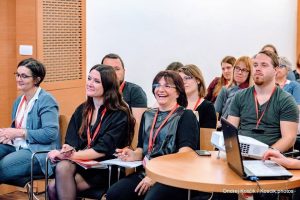
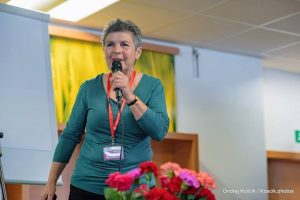
This year’s IATEFL SLOVENIA conference welcomed us to their 25th Jubilee Conference. The theme of the conference was IMAGINE which attracted Ezgi Öner and I so much that we wanted to take part in this conference. Our main aim to attend this conference was because we had implemented a lot of creative tasks and projects to our classes in the previous academic year. The title of our talk was: Increasing creativity and motivation with project works in
learning environment. So, the theme of the conference motivated us so much that we couldn’t stop ourselves from joining it. Even the theme of the conference dinner was based on the same topic which was the 70s party. It was a great conference with many interesting and fruitful talks, workshops and plenaries with many other activities such as the Poetry Competition, which didn’t get any prize for, though.(see my poem below). And another activity at night was the Lip Singing Activity where I sang Tarkan’s song “Kiss kiss”. Although that song didn’t win a prize, either, I will continue singing.
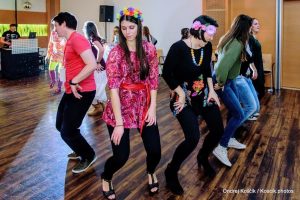

Although I had taken part in many conferences, this conference stood out with the enthusiasm and the eagerness of the participants and the presenters which made everyone admire every aspect of the conference.
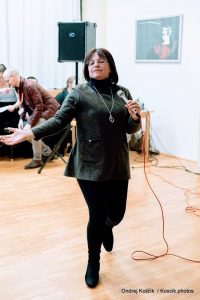
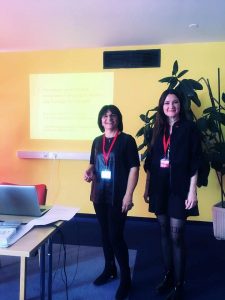 Having attended many conferences in Turkey and abroad for the past 30 years, I felt the privilege to have joined the plenary session of Penny Ur who had been my tutor while I was doing my Teacher Training Certificate Programme at Fitzwilliam College (Cambridge) in the summer of 1996. So, I was going to have the chance to see one of the best gurus whose book (Grammar Practice Activities) had been my bible throughout my teaching career. Moreover, I was sure that I was going to hear the latest developments of ELT in her session.
Having attended many conferences in Turkey and abroad for the past 30 years, I felt the privilege to have joined the plenary session of Penny Ur who had been my tutor while I was doing my Teacher Training Certificate Programme at Fitzwilliam College (Cambridge) in the summer of 1996. So, I was going to have the chance to see one of the best gurus whose book (Grammar Practice Activities) had been my bible throughout my teaching career. Moreover, I was sure that I was going to hear the latest developments of ELT in her session.
The session focused mainly on what effective teaching is and how much time teachers spend in class for doing certain activities.
She started her session by showing seven statements that describe possible defining characteristics of an effective teacher to the audience and asked them how important each of them meant for teachers.
Which would in your opinion be the most important, or ‘key’ criterion for effective teaching?
1. Students are clearly motivated to come to his/her classes.
2. He/She creates a supportive classroom climate.
3. His/Her lessons are based on communicative task-based work.
4. His/Her students are constantly activated in class.
5. His/Her students learn English well.
6. His/Her lessons are orderly; students are consistently on-task.
7. He/She loves his/her students.
She continued her talk by emphasizing the fact that whatever “key factor” teachers select, teachers will not be able to have clear sets of ideas in their minds because although there is a lot of research on this topic, it doesn’t help very much since there are too many different components and models but it seems clear that the choice of methodology is not a crucial factor.
(Clarke et al., 1996).
Then she focused on the importance of TASK (process) and ACHIEVEMENT (product):
For example, look for would be PROCESS and find would be PRODUCT. As teachers, we sometimes focus on process in our classes and sometimes on products because teaching can be seen as:
• Means-oriented (task, process, facilitation of learning, creating conditions for learning)
• End-oriented (achievement, product, leading to learning).
Effective teaching is that which achieves the end. So, when we look at the statement: “Her students learn English well”, we have to ask ourselves the following: “Do they do well in the end?”
The means should be evaluated chiefly on the basis of how well they contribute to this end.
However, when we look at the past and compare different methodologies such as traditional methods, grammar translation methods or project work applied by different teachers, we can see that they all were effective teachers with outstanding results. So, effective teaching does not only depend on what the teacher covers in class but also what the outcome is.
The second part of the plenary focused on the use of TIME. She started by emphasizing the quote:
“The more effective the teaching, the more real learning will take place in any given unit of time”. (Research on ‘academic learning time’ (ALT) Berliner, 1990; Gettinger & Walter, 2015
How important is TIME in class? How much time is wasted in classes? These two questions were based on the fact that:
• Time in school is NOT all learning time.
• Time in lessons is NOT all learning time.
• Teaching time is NOT all learning time.
• Time on task is NOT all learning time.
• LEARNING TIME is OPTIMUM LEARNING
She continued by saying that teachers all waste time in their classes. Ways of wasting time:
• Profitless “busy” time
• Wrong choice of language
• Inappropriate interaction pattern
When we look at our own classes, most teachers play HANGMAN or PUZZLES in their classes but why do they choose such an activity: They’re busy, but are they learning anything?
Tasks that involve a lot of (sometimes interesting / absorbing) activity that do not contribute much to learning because a lot of time is spent:
… puzzling out;
… searching;
… organizing group work;
… formatting/designing.
Lastly, she focused on what language teachers choose to do certain things: L1 or L2
• Teaching grammar
• Teaching vocabulary
• Giving instructions
• Group work /project work
Should we spend a lot of time explaining a vocabulary item in L2 or saying it in L1 so that students can continue with the task? Or should we explain the steps of some kind of project work in L2 in 15 minutes and not give adequate time to the project task that students need to prepare? The answer would be using students’ mother tongue is better because it is faster: leaves more time for engaging with English itself. Or would teachers prefer to use L1 or L2 when teachers want the learners to understand a point of grammar? Probably L1 is preferred here because when the teacher explains it, it is likely to be quicker, clearer and more accurate. But if the level is appropriate, then the teacher can elicit the rules form the students.
All these questions that she raised in her plenary made teachers aware of what they really need to focus in their classes and use their precious times where real learning will take place.
Effective Teaching = Real Learning in Class
She concluded her plenary by summarizing what was argued in the session:
1. Effective teaching is first and foremost that which brings about effective learning.
2. Effective teaching is primarily a function of appropriate use of time in lessons for learning
BUT:
1. How might the age / level / character of the class affect our priorities?
2. Is effective learning of English in a lesson always our main objective?
3. Are there situations where short-term ‘ineffective’ lessons may lead to long-term benefits?
4. Are there situations where ‘time-wasting’ activities are actually a good idea?
There may be various considerations in making decisions as to what to include in a lesson, but the most important principle should be:
‘What will bring about the most effective learning on the part of my students in the lesson-time at my disposal?’
Thank you very much Penny. It was a pleasure listening to you.
My poem:
IMAGINE a class
IMAGINE a country
IMAGINE a world
Imagine a class where there is only peace, relaxation and laughter.
Where everyone is equal and where there is no slaughter.
Imagine a class in which all students are engaged and arranged
Imagine a class where all students understand you.
A class that doesn’t want to hurt you.
So, where there is only love.
Just imagine and make it come true.
Imagine a country where there is only freedom.
Where there is only equality and there is no kingdom.
Imagine a country where all the people can live freely and safely.
Where women are not beaten up terribly.
Where children are not abused or hurt.
Imagine a country where there is no hate
Where no one is late.
Imagine a country where Syrians and other nations are welcome.
Where all people have enough income.
Where there is enough food for everyone.
Where there is work for everyone.
Imagine a country where there is only one LOVE.
Imagine a world without borders, without visas and without hostages.
Imagine a world without languages, without misunderstandings.
Imagine a world without plastic, without trash and without clashes.
Imagine a world without kings, bombings or killings.
Imagine a world where people have all the things.

Leave a Reply